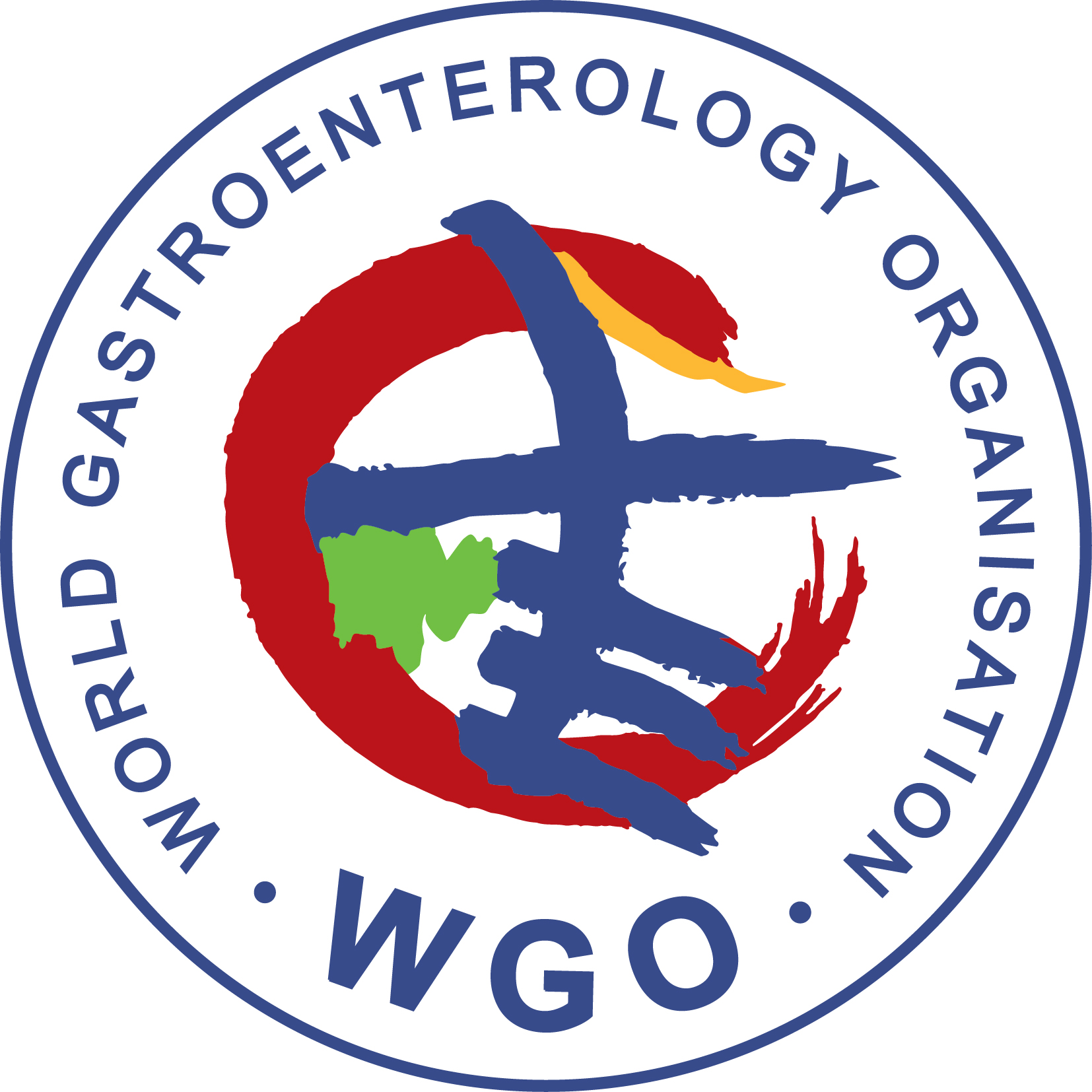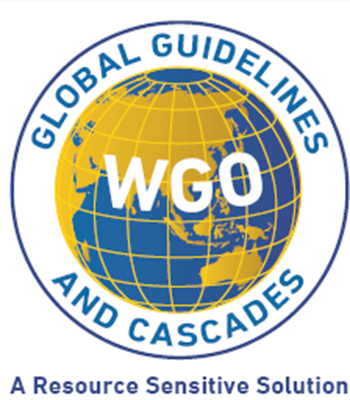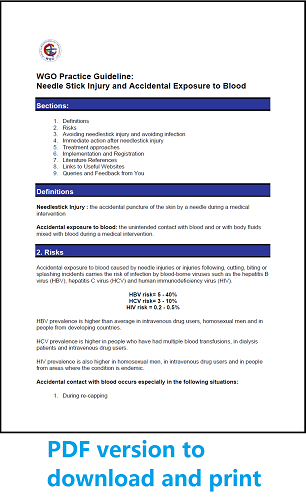Needlestick Injury: the accidental puncture of the skin by a needle during a medical intervention
Accidental exposure to blood: the unintended contact with blood and or with body fluids mixed with blood during a medical intervention.
Accidental exposure to blood caused by needle injuries or injuries following, cutting, biting or splashing incidents carries the risk of infection by blood-borne viruses such as the hepatitis B virus (HBV), hepatitis C virus (HCV) and human immunodeficiency virus (HIV).
HBV risk= 5 - 40%
HCV risk= 3 - 10%
HIV risk = 0.2 - 0.5%
HBV prevalence is higher than average in intravenous drug users, homosexual men and in people from developing countries.
HCV prevalence is higher in people who have had multiple blood transfusions, in dialysis patients and intravenous drug users.
HIV prevalence is also higher in homosexual men, in intravenous drug users and in people from areas where the condition is endemic.
Accidental contact with blood occurs especially in the following situations:
- During re-capping
- During surgery, especially during wound closure
- During biopsy
- When an uncapped needle has ended up in bed linen, surgery clothing etc
- When taking an unsheathed used needle to the waste container
- During the cleaning up and transporting of waste material
- When using more complex collection & injection techniques
- In A&E (Accident and Emergency) departments
- In high-stress interventions (diagnostic or therapeutic endoscopy in patients with gastrointestinal bleeding)
Although this does not occur very often, there are other blood-borne microorganisms which can be transmitted via blood exposure:
- Other hepatitis viruses
- Cytomegalovirus (CMV)
- Epstein-Barr virus (EBV)
- Parvovirus
- Treponema pallidum (syphilis)
- Yersinia
- Plasmodium
Accidental exposure to blood following a needlestick injury is probably one of the most common occupational health accidents in medical care.
3.1. General
The single most important measure to prevent needlestick injury is to not put the used needle back in its original cover; re-capping and re-sheathing must be avoided. Instead use a rigid puncture-proof container for used needles. It is important that the container is always close to hand to avoid the temptation of re-capping. It is equally important to use proper protective clothing such as gloves, mouth mask, and goggles which are appropriate during the performance of endoscopy.
3.2. Prevention
The most important rule for preventing needlestick injury is not to put the needle back in its cover, instead, the needle should be put in a specially designed, rigid, puncture-proof needle container. Make sure the container is always at hand.
3.2.1. Vaccination
Every hospital employee or any healthcare personnel at risk from accidental exposure to blood should be vaccinated against HBV. There are no preventive vaccines available yet for HCV and HIV.
3.2.2. Prevention of accidental blood contact
Personal protective equipment and clothing is very important. Use mouthmasks, gloves and gowns. Double gloving is safer than single gloving. Each additional layer of protective barrier (such as one or two gloves) significantly reduces the threat of any infectious agent present on the outside of the needle. Research shows a decreased or absent needlestick injury risk when using prior skin puncture techniques, or when using a needle-free delivery mechanism with safeguard mechanisms (safety barrel) or blunt tipped needles, can reduce the frequency of needlestick injury. Adequate training in safety procedures and improved compliance with safe operating room behavior can significantly reduce injury and infection risks. The maintenance of a safe operating room atmosphere is totally dependent on the atmosphere set by the operator.
3.2.3. Disinfection of contaminated material
After spilling possibly contaminated materials the affected area should be cleaned immediately (wearing gloves!) and then disinfected. Nursing equipment and materials , tools and small surfaces are cleaned with 70% alcohol. Large surfaces such as floors are disinfected with a chlorine solution 1000 ppm.
Taking care of the wound immediately after the accident
Let the wound bleed for a moment and then cleanse thoroughly with water or a saline solution. Disinfect the wound using an ample amount of soap and water followed by 70% alcohol. In case of contact with mucous membranes it is important to rinse immediately and thoroughly, using water or a saline solution only, not alcohol.
Reporting the incident
It is important to report the incident immediately to the department dealing with occupational accidents. This will allow proper registration and subsequent management of the event.
Immediate action (injured person)
A blood sample should be taken as soon as possible after the injury. This sample should be kept for at least one year. It can act as a baseline value in case infection takes place and it becomes necessary to determine whether infection by one of the three viruses occurred at work. The kept sample may only be analysed for this particular purpose. Further blood samples to test for HBV, HCV and HIV are collected after 1, 3, 6 and 12 months.
Immediate action (dealing with the potential source)
If the source of the blood is known the patient must be asked for permission to sample blood for a HCV and HIV test. If the patient refuses then it must be assumed the patient is a carrier of the virus. If the origin of the blood is unknown then any blood present on the needle can be used for a serological examination.
Table One: Accidental Exposure to Blood - Flowchart
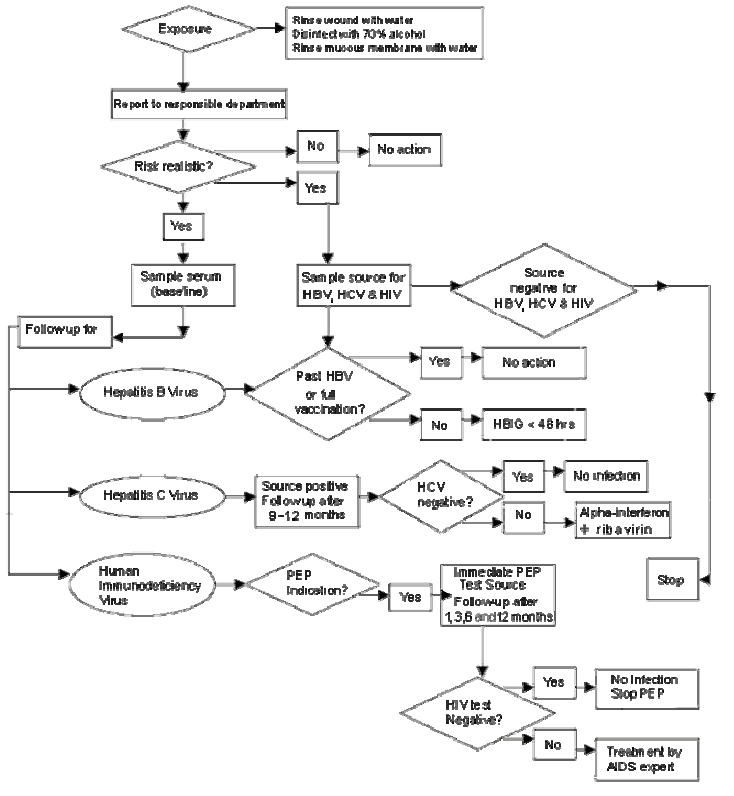
Note: PEP = Post Exposure Prophylaxis (see 5.4.2)
5.1. General Prophylaxis
Management is based on finding out whether there is a risk of HBV, HCV or HIV . Depending on the serological analysis of the sample, steps must be taken to limit infection risks from the identified virus.
5.2. What to do after a potential HBV infection
Management of the situation is based on whether or not the injured person is immune for HBV, either as a result of vaccination or otherwise. There are two possibilities:
- Subject has full immunity, if:
- the person has had at least three vaccinations against HBV plus a subsequent check for antibodies
- the response after vaccination is more than 10 IU/l
- the person has had hepatitis B in the past.
- Subject has a partial (or no) immunity, if:
- there was only a limited vaccination against HBV or none at all. Should this be the case then 5 ml intramuscular hepatitis B immunoglobulin (HBIG) should be given within 48 hours of the injury.
Table Two: Prevention of HBV infection after accidental exposure to blood
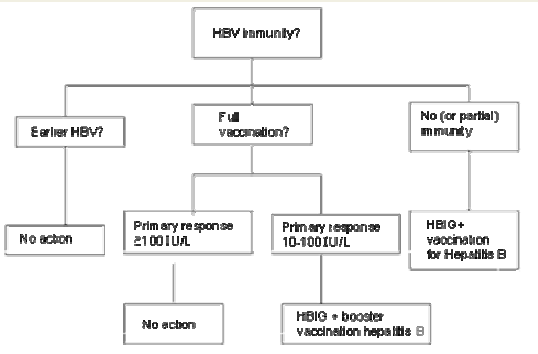
5.3. What to do after a potential HCV infection
There is no effective drug prophylaxis for HCV. There are some experimental treatment possibilities provided the infection is diagnosed at an early stage. The case should be followed closely for 12 months and a serological examination for HCV should be done after 3, 6 and 9-12 months. If one of these follow up analyses finds HCV antibodies then a comparison with the baseline blood sample taken immediately after the accident will show whether or not this involves an occupational accident. In case of a positive HCV test, a combination treatment of interferon and ribavirin is the treatment of choice. A liver specialist should be consulted.
5.4. Risks and what to do after a potential HIV infection
5.4.1. Risk of HIV Infection
The risk of a HIV infection following exposure to blood is very small (0.1-0.5%). The actual risk depends on type of contact and on the amount of virus in the contaminated material.
Table 3: HIV infection risk after accidental contact with blood Post Exposure Prophylaxis (PEP) recommendation
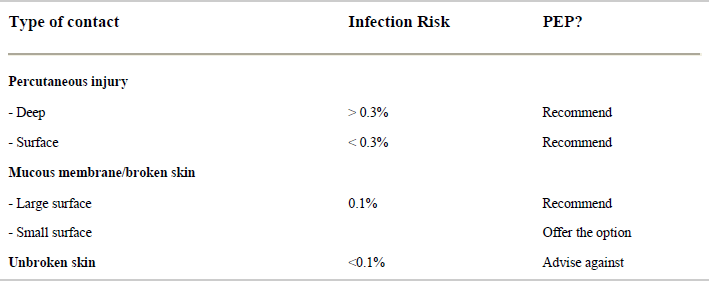
The chance of an HIV infection can be reduced considerably if an early start can be made - within 2- 8 hours - with HIV inhibitors.
There are some factors which are associated with a higher risk
- Deep wounds
- Visible blood on the instrument
- Needlestick injury by using hollow-bore needles containing blood
- Intravenous or intramuscular injection of contaminated blood
- Blood from a patient with a high virus level (for example untreated or terminal AIDS patients)
Immediate action after Needlestick Injury
After a review of the accident with the doctor responsible for occupational health and safety a recommendation is given whether or not to prescribe Post Exposure Prophylaxis (PEP). If in doubt it is best to contact an AIDS expert. If PEP is advisable then it is important to discuss :
- the advantages and disadvantages of PEP
- the necessary follow-up examinations (of liver and kidneys) after 2 weeks, 1, 3 and 6 months)
- follow up examination for HIV infection (after 1, 3 and 6 months)
- the importance of avoiding transmission to sexual partner(s) (use of condoms)
Start PEP as soon as possible after this.
Table 4: PEP or no PEP
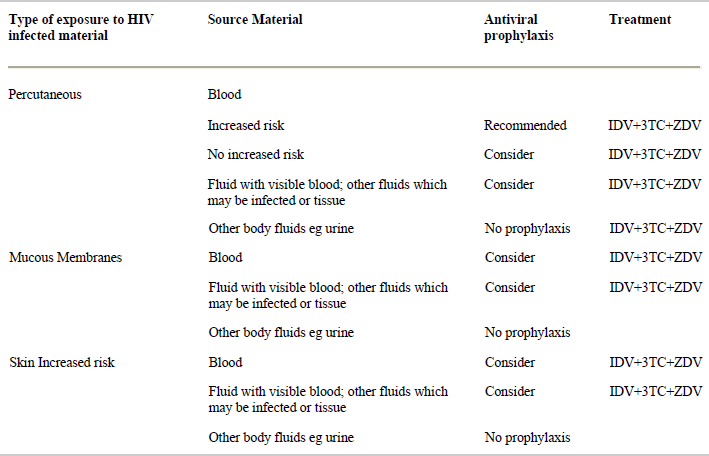
5.4.2. Post Exposure Prophylaxis (PEP) for high HIV infection risk cases
General
PEP is the treatment of choice. Recommended is a 3-drug combination consisting of 2 RT (reverse transcriptase) inhibitors and 1 protease inhibitor. If the source patient is infected with a resistent virus it may be advisable to discuss a modified regimen with an internist-AIDS specialist.
The standard PEP consists of :
Indinavir
Lamivudine
Zidovudine
Early monotherapy with zidovudine reduces the likelihood of HIV infection by as much as 80%. The main disadvantages of PEP concern the potentially harmful side-effects and the fact that its longterm drug toxicity is unknown.
Commence treatment early
Considering the speed with which the virus multiplies and the results of animal experiments it is recommended to start PEP within 6 hours of suspected exposure. Do not wait for laboratory results , start PEP at once. In most cases it is possible to stop PEP immediately after the results prove negative and thus avoid potential adverse events.
Which drugs to use
A standard PEP set can be used. The total course should take 4 weeks (28 days). See tables 5 and 6 for dosing information.
Potential side-effects
Indinavir
stones in kidneys and urinary tract if not drinking enough water
Lamivudine
side effects are rare
Zidovudine
headache and nausea (temporary) anemia liver function disorders
Follow-up
Follow-up examinations are important. Privacy should always be respected and laboratory results should be anonymous. Blood samples in connection with possible side effects (hematologic, hepatic,renal, etc) are taken at the start of treatment and after 2 and 4 weeks. Blood samples for HIV are taken at the start of the treatment and after 1, 3 , 6 and 12 months. If the results are still negative after 6 months, it is very unlikely that an HIV infection has taken place, but blood should be taken after 12 months to exclude rare delayed seroconversion. More than 95% of well-documented HIV seroconversions occur within the first 3-12 weeks.
Table 5: PEP dosage Adults
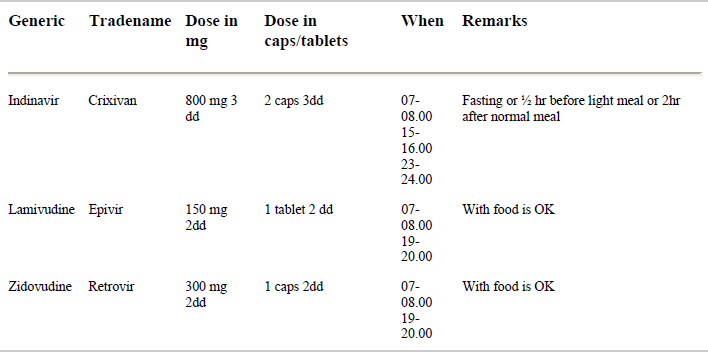
Table 6: PEP dosage Children
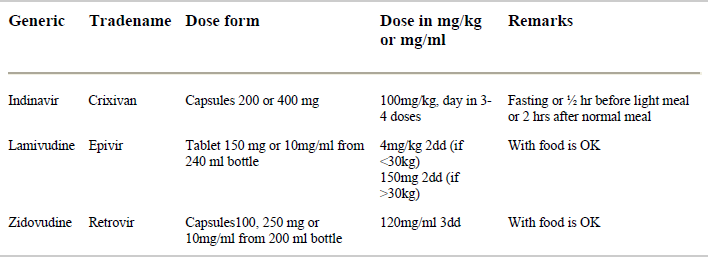
Table 7: Indinavir dosages - Children
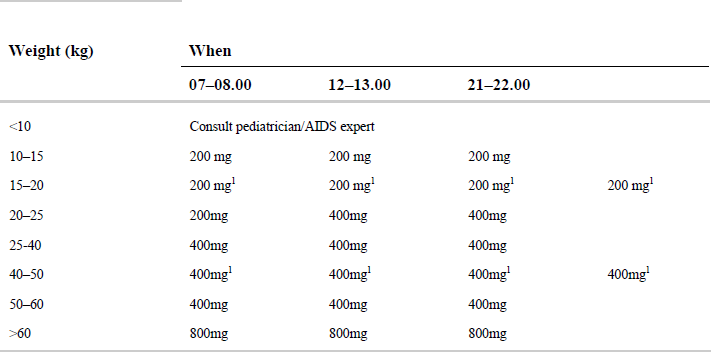
1Divide dose over the day with a minimum 4 hours between each dose and a maximum of 6 hours between each dose.
Compliance and Training Issues
There is a clear relationship in the literature between risk, compliance and training. Good training will improve compliance with safe operating room behavior and reduce the risk of Needlestick Injury.
All healthcare staff should be vaccinated for HBV. All Needlestick Injury events should be registered and carefully documented.
A comprehensive list of literature references plus a copy of the online search strategies used is available on request by clicking the feedback box below.
INVITATION TO COMMENT
The Practice Guidelines Committee welcomes any comments and queries that readers may have. Do you feel we have neglected some aspects of the topic? Do you think that some procedures are associated with extra risk? Tell us about your own experience. You are welcome to click on the link below and let us know your views.
info@worldgastroenterology.org


